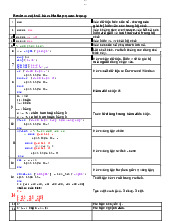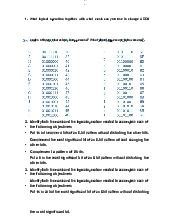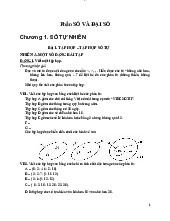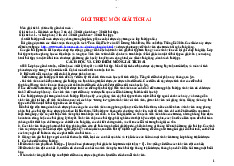










Preview text:
lOMoARcPSD|44744371 lOMoARcPSD|44744371 Unit 6: Exercise 1
In this unit, you will look at Yes / No / Not Given questions and
summary completion. You will read a text about travel photography.
Read the information. Then read the sentences about photography and decide if
they are the writer’s views or claims.
For IELTS Reading Yes / No / Not Given questions, you need to recognise and understand
the views and claims that a writer expresses in a text:
a view is the writer's opinion about something. Example:
The best way for students to spend their free time is in travelling and taking photos.
a claim is something that the writer believes is a fact – information they understand to be true. Example:
The first modern photograph was taken in France in 1826 or 1827.
1. I was delighted with the way my photographs turned out. o View o Cliam
2. One of the world’s first travel shoots took place in 1849. o View o Cliam
3. Photographers now need to be more flexible about the kind of projects they work on. o View o Cliam
4. Some groups of native Americans strongly dislike photographs. o View o Cliam
5. The festival is held in November. o View o Cliam
6. This festival should be included in any photographer’s diary. o View o Cliam lOMoARcPSD|44744371 Unit 6: Exercise 2
Read the information and look at the examples of both views and claims. Then
complete the statements based on the examples.
The bold words in the sentences below can help you to work out whether a sentence is a view or a claim. Views Examples:
The best way for students to spend their free time is travelling and taking photos.
I was delighted with the way my photographs turned out.
This festival should be included in any photographer’s diary.
Photographers now need to be more flexible about the kind of projects they work on. Claims Examples:
The first modern photograph was taken in France in 1826 or 1827.
One of the world’s first travel shoots took place in 1849.
The festival is held in November.
Some groups of native Americans strongly dislike photographs.
1. Modal verbs for advice, necessity or obligations (e.g. should, need) are more common in views / claims.
2. Words and phrases that describe when something happens are more common in views / claims .
3. Words and phrases for feelings, emotions and attitudes are more common in views / claims .
4. Words and phrases that describe where something happens are more common in views / claims . lOMoARcPSD|44744371
5. Words and phrases for quantities (e.g. all, most, few) and qualities such as
colour, size, age, shape, etc. are more common in views / claims .
6. Words and phrases that give advice or make suggestions are more common in views / claims . Unit 6: Exercise 3
Read the information. Then read the first paragraph of an article on travel
photography and the statement which follows. Decide if the statement agrees
with a view or claim of the writer. Choose the correct answer.
In an IELTS Reading Yes / No / Not Given task, you read a text in which the writer
expresses some views or makes some claims. Then you decide if a set of statements agree
with the writer’s views or claims in the text.
If the statement expresses the same idea as the writer, the answer is Yes.
If the statement expresses the opposite idea to the writer’s, the answer is No.
If the statement expresses an idea that the writer does not express any views or
claims about, the answer is Not Given.
‘Eyes on the World’: Travel photography in the 21st century
One of the world’s first travel shoots took place in 1849 when two young Frenchmen,
Gustave Flaubert and Maxime Du Camp, decided they would set out on a great adventure
and travel to Egypt. Du Camp took hundreds of photographs of the Pyramids and the Sphinx,
and when he returned home and published his travel album, the images amazed the European
public and turned Du Camp into a celebrity overnight.
Maxime Du Camp became famous because of the photos in his travel album. o Yes o No o Not Given Unit 6: Exercise 4
In the IELTS Reading task, choosing No or Not Given can sometimes be
more difficult than choosing Yes. lOMoARcPSD|44744371
Read the paragraph again. Then choose the correct answers
‘Eyes on the World’: Travel photography in the 21st century
One of the world’s first travel shoots took place in 1849 when two young Frenchmen,
Gustave Flaubert and Maxime Du Camp, decided they would set out on a great adventure
and travel to Egypt. Du Camp took hundreds of photographs of the Pyramids and the Sphinx,
and when he returned home and published his travel album, the images amazed the European
public and turned Du Camp into a celebrity overnight.
1. The European public was disappointed with the photos in Maxime Du Camp’s travel album. o No o Not Given
2. The European public saw photos of Egypt for the first time when they looked at Du Camp’s travel album. o No o Not Given
3. Maxime Du Camp was surprised by the amount of attention he received after publishing his book. o No o Not Given
4. It took a long time for Maxime Du Camp to become famous after he published his travel album. o No o Not Given lOMoARcPSD|44744371 Unit 6: Exercise 5
Read the information. Then read the statements 1–7.
Match the synonyms and paraphrases in the box with the bold words and phrases in the statements.
In an IELTS Reading Yes / No / Not Given task, it is important to look for paraphrases of
the statements in the text. This will make it easier to decide the correct answer. Dangerous event great is now acceptable outsiders work hard for
realise what the challenges were
1. Most photographers understand how hard it was to take photographs in the 19th
century. _________________________________
2. Some of the chemicals that Du Camp used for his photography were unsafe .
___________________________________
3. There is a lot of luck involved in taking really good photographs.
__________________________________
4. It’s usually photographs that require a lot of effort that professional photographers
are most pleased with. _______________________________________
5. All Souls Day in the Philippines is an older festival than the Day of the Dead in
Mexico. ________________________________________
6. Mexican locals are happy for foreigners to attend Day of the Dead celebrations.
____________________________________
7. It has become common for some native American groups to photograph
important ceremonies. __________________________________ Unit 6: Exercise 6
Read the information. Then read the next four paragraphs of the ‘Eyes on
the World’ article. Answer the questions
While Du Camp’s photographs may appear simple in comparison to modern photographs
with their special effects, it seems to me that nowadays the majority of photographers fail to
realise what the challenges were in taking photographs in the 19th century. To begin with,
foreign travel was expensive and difficult to organise. Fortunately, Du Camp had money of lOMoARcPSD|44744371
his own and he was also able to get additional funding for the journey from the French
government. Another issue was the size and weight of 19th-century cameras – they were
very large and heavy. Finally, not only was there a great deal of equipment and chemicals to
transport, but travelling itself could be highly dangerous. Of course, travel photographers do
still take risks as part of their job, but the level of danger is hardly the same as when Du
Camp was travelling across continents.
Nevertheless, as any professional photographer knows, to be good at the job still requires
hard work and dedication. The popular idea that great photographs are often the result of a
photographer being in exactly the right place at exactly the right time, just by chance, does
not reflect reality. Last year, for example, on a visit to Reykjavik, Iceland, I met several
photographers I knew. We were all there for the annual Winter Lights festival, involving
works by many artists and musicians. One shot we all wanted was the perfect image of the
aurora borealis – the strange green lights that sometimes appear briefly in the sky as the sun
is going down. It took hours for everyone to decide how best to catch this moment and to
work out where to place themselves to get the best result. In the end, I was delighted with the
way my photographs turned out. In general, professional photographers share the feeling that
the most rewarding photographs are the ones you’ve worked hard for.
Events like this attract photographers because the atmosphere can help create some wonderful
photo opportunities. The Day of the Dead in Mexico is a perfect example. Although other
countries have a similar event, for example, All Souls Day in the Philippines, the Mexican
event is a photographer’s dream. It’s a time of celebration, when people remember relatives
who have already passed away. Good photographs will capture that sense of joy in the bright
and colourful decorations on the gravestones and in the faces of the families who are using
humour and art to remember their dead. What’s more, the local people are usually happy to
share this experience with outsiders so visitors can participate if they wish. The festival is
held in November, and should be included in any photographer’s diary.
Travelling as a photographer has encouraged me to question some ideas I previously
believed to be true. An example of this is the popular belief that some groups of native
Americans strongly dislike photographs and will turn away from cameras. This, however, is
not the case. From talking to native Americans I’ve met on my journeys, it seems that it is
now acceptable to regard photographs as valuable connections to ancestors and even include
them in important ceremonies, some of which I have been lucky to observe and record.
Read the statements and choose the correct answers. Read the text on page 1 again if you need to.
Note that the words and phrases for expressing views and claims have been underlined here for reference. 1. M
ost photographers understand how hard it was to take photographs in the 19th century. o Yes lOMoARcPSD|44744371 o No o Not Given 2. S
ome of the chemicals that Du Camp used for his photography were unsafe. o Yes o No o Not Given
3. There is a lot of luck involved in taking really good photographs. o Yes o No o Not Given
4. It’s usually photographs that require a lot of effort that professional photographers are most pleased with. o Yes o No o Not Given
5. All Souls Day in the Philippines is an older festival than the Day of the Dead in Mexico. o Yes o No o Not Given 6. M
exican locals are happy for foreigners to attend Day of the Dead celebrations. o Yes o No o Not Given
7. It has become common for some native American groups to photograph important ceremonies. lOMoARcPSD|44744371 o Yes o No o Not Given Unit 6: Exercise 7
Read the final paragraph of the ‘Eyes on the World’ article carefully.
Then choose the four ideas which are found in the text.
One question that people often ask is whether it’s possible to make a reasonable living in the
travel photography industry today. Gone are the easy days when photographers simply shot
photos for magazines and newspapers, sent them to an editor and got paid at the end of every
month: these forms of media now usually buy photos for their stories directly from
companies that store millions of them. As a result, photographers now need to be more
flexible about the kind of projects they work on. One way to do this is by working for big
businesses. In the past, photographers often decided where they would like to go, and could
perhaps experiment more with the kinds of photographs they took. However, working for a
big business often means that you are sent where the company wants you to go; perhaps to a
beach or a mountain if they want to promote these as tourist destinations. The desert is
another popular place: many car companies like to shoot this kind of background to advertise
their new vehicles. Of course, nowadays this kind of well-paid work opportunity is very
popular, so a huge number of photographers will all apply for the same job; a situation
which you didn’t see so much in the past. Nevertheless, in my experience, whether
photographers are amateurs or professionals, there is a generally positive feeling between
them: they are supportive of each other and willing to share advice about work opportunities
and the risks that travelling to foreign destinations sometimes involves.
□ Some photographers like to take photographs of serious subjects while others like to take amusing ones.
□ The typical career of a photographer is not the same today as it was in the past.
□ Newspapers no longer buy so many photographs from individual photographers.
□ Big businesses sometimes use photographers to take pictures of their products or services.
□ The internet has made it much easier to see the work of many photographers.
□ There are a huge number of training courses if people want to study photography. lOMoARcPSD|44744371
□ Photographers talk to each other about their experiences and provide useful information. Unit 6: Exercise 8
Read the information. Then match the paraphrases and synonyms in the box
with the ideas in the sentences.
For an IELTS Reading summary completion task you:
should carefully read the part of the article which is being summarised to understand the main ideas;
should carefully read a gapped summary;
may need to choose words or phrases from a box to complete the summary.
You will need to recognise synonyms and paraphrases in the text when you do this task successfully. good relationships great competition international exhibitions marketing purposes new ideas public interest regular income work experience
1. The photographs are displayed in a gallery. _____________________________
2. Each month, the photographers get money for their work.
_______________________________
3. People really enjoy looking at their photographs. _____________________________
4. The photographers make suggestions and plans about what to do next. ____________________________
5. The photographers do the job to improve their skills but they don’t get paid anything. ______________________________
6. The photographers get on well with each other. _________________________
7. Some people use photographs to persuade other people to buy things.
_________________________________
8. A lot of photographers are all trying to get the same job.
____________________________________ lOMoARcPSD|44744371 Unit 6: Exercise 9
Read the final paragraph of the text again. Then choose the correct words or
phrases to complete the summary.
One question that people often ask is whether it’s possible to make a reasonable living in the
travel photography industry today. Gone are the easy days when photographers simply shot
photos for magazines and newspapers, sent them to an editor and got paid at the end of every
month: these forms of media now usually buy photos for their stories directly from
companies that store millions of them. As a result, photographers now need to be more
flexible about the kind of projects they work on. One way to do this is by working for big
businesses. In the past, photographers often decided where they would like to go, and could
perhaps experiment more with the kinds of photographs they took. However, working for a
big business often means that you are sent where the company wants you to go; perhaps to a
beach or a mountain if they want to promote these as tourist destinations. The desert is
another popular place: many car companies like to shoot this kind of background to advertise
their new vehicles. Of course, nowadays this kind of well-paid work opportunity is very
popular, so a huge number of photographers will all apply for the same job; a situation
which you didn’t see so much in the past. Nevertheless, in my experience, whether
photographers are amateurs or professionals, there is a generally positive feeling between
them: they are supportive of each other and willing to share advice about work opportunities
and the risks that travelling to foreign destinations sometimes involves.
Nowadays photographers no longer receive regular income/ exhibitions from the work they do,
and they need to look for different kinds of project. One option is to get a job with a large
company and take photographs for marketing purposes/ public interest . A job like this is
attractive to many photographers, and there is new ideas/ great competition between them.
However, it is also true that in general, photographers form good relationships/ work
experience with each other, no matter whether they take photos for fun or as a career. Unit 6: Exercise 10
Think about what you’ve learnt in this unit.
Complete the advice. Use the words in the box. lOMoARcPSD|44744371 attitude or feelings is a claim is his or her view read the statements same order statements summarise parts of the text text very carefully
understand a writer’s views and claims when or where
1. Yes / No / Not Given questions check how well you can _______________________
2. Something that a writer believes to be true _______________________
3. The writer’s personal opinion about something _______________________
4. Claims often include factual information such as _______________________ something happens.
5. Views often include expressions of the writer’s _______________________ about something.
6. Yes / No / Not Given questions are always _______________________
7. Statements in Yes / No / Not Given tasks follow the _______________________ as the text.
8. In the Yes / No / Not Given task, it is a good idea to _______________________ before you read the text.
9. In the summary completion task, you should read the _______________________
10. In the summary completion task, you need to choose words that _______________________




